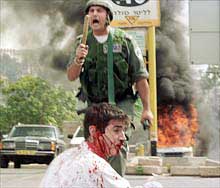MYTH
“The Palestinians have never been offered a state of their own.”
FACT
The Palestinians have actually had numerous opportunities to create an independent state, but have repeatedly rejected the offers:
In addition, from 1948 to 1967, Israel did not control the West Bank. The Palestinians could have demanded an independent state from the Jordanians. The Palestinians have spurned each of these opportunities.
- In 1937, the Peel Commission proposed the partition of Palestine and the creation of an Arab state.
- In 1939, the British White Paper proposed the creation of a unitary Arab state.
- In 1947, the UN would have created an even larger Arab state as part of its Partition Plan.
- The 1979 Egypt- Israel peace negotiations offered the Palestinians autonomy, which would almost certainly have led to full independence.
- The Oslo agreements of the 1990's laid out a path for Palestinian independence, but the process was derailed by terrorism.
- In 2000, Prime Minister Ehud Barak offered to create a Palestinian state in all of Gaza and 97 percent of the West Bank.
- In 2008, Prime Minister Ehud Olmert offered to withdraw from almost the entire West Bank and partition Jerusalem on a demographic basis.
MYTH
“The Palestinian question is the core of the Arab-Israeli conflict.”
FACT
In reality, the Palestinian question is the result rather than the cause of the conflict, and stems from Arab unwillingness to accept a Jewish State in the Middle East.
Had Arab governments not gone to war in 1948 to block the UN Partition plan, a Palestinian state would now be celebrating more than 60 years of independence. Had the Arab states not supported terrorism directed at Israeli civilians and provoked seven subsequent Arab-Israeli wars, the conflict could have been settled long ago, and the Palestinian problem resolved.
From 1948–1967, the West Bank and Gaza were under Arab rule, and no Jewish settlements existed there, but the Arabs never set up a Palestinian state. Instead, Gaza was occupied by Egypt, and the West Bank by Jordan. No demands for a West Bank/Gaza independent state were heard until Israel took control of these areas in the Six-Day War.
From: JewishVirtualLibrary.org
Book by: Mitchell G. Bard




















